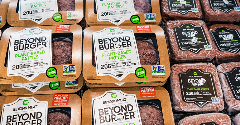News
Spotlight on Salt, Fat and Sugar Reduction
22 Oct 2013Watching the obesity rate tick slowly upward year by year, it becomes apparent that consumers struggle with controlling their weight. The health consequences of obesity, and the direct impact it has on health care costs, has seen government and health authorities continue to place pressure on food manufacturers to take action against obesity and help […]

Watching the obesity rate tick slowly upward year by year, it becomes apparent that consumers struggle with controlling their weight. The health consequences of obesity, and the direct impact it has on health care costs, has seen government and health authorities continue to place pressure on food manufacturers to take action against obesity and help consumers make responsible dietary decisions. Consequently, sugar and fat reduction continue to be top priorities for food and drink manufactures in an attempt to lower the calorie load from sugar and fat, as excessive intakes of both nutrients contribute to weight gain.
Reducing the fat content of products presents challenges, from both a taste and functionality point of view. Fat not only adds energy-dense calories, but it contributes important sensory benefits to food and drink formulations, from the perception of mouth-feel, taste and aroma. When fat is removed from a formulation, these sensory attributes are compromised and in the UK, almost a quarter of consumers believe that taste is compromised in low fat products. The ‘naturalness’ of reduced fat formulations can also suffer, as, in place of fat, functional additives such as sweeteners and bulking agents have to be included to compensate for the loss of taste and texture. Reducing the sugar content of food and drink products presents similar challenges, with sugar adding both bulk and flavour. High intensity sweeteners offer sweetness without the calories; however, their typically artificial nature can put some consumers off, with the general shift away from synthetic food additives as well as their ‘artificial’ taste. However, the growing popularity of the naturally-derived high intensity sweetener stevia provides a low/no calorie natural alternative to sugar – but, as the artificial variants struggle to satisfy on a taste front, stevia has so far struggled with similar issues.
Attention has also been given to reducing the sodium and salt content across food and drink products. With the high amount of salt hidden in processed foods, our taste buds have been trained to expect and crave salty food, contributing to most individuals exceeding their daily sodium intake. Most food manufacturers have employed a gradual and stealthy approach to sodium reduction, to allow the taste buds of consumers to slowly adapt over time to less salty products. However, sodium-reduced products are often rejected on their actual or perceived taste, as they compete with and are compared to their higher-sodium equivalents. A range of different strategies have been employed to reduce the sodium content across processed foods, with salt alternatives and flavour enhancers all essential tools in the ‘sodium reduction toolbox’. A recent study examined whether the distribution of salt in snack foods altered the perception of saltiness. The results showed that a heterogeneous salt distribution better masked reduced sodium products than a homogeneous distribution, supporting a random distribution of salt when designing low-salt foods. At present, a multi-pronged approach to sodium reduction is required to tackle the current problems to overcome a range of issues from taste and acceptance of products, to food safety and food quality.
Sugar, salt and fat reduction will continue to be a research priority for food and drink manufacturers in an attempt to help tackle the obesity epidemic: however, considerable work to replicate the taste and appeal of these products is still required.
Related news

PepsiCo formulates ‘naked’ Cheetos and Doritos products
31 Dec 2025
US food giant PepsiCo has launched its Simply NKD range, a move it says reimagines its popular products with new formulations free from artificial flavours, dyes, and colours.
Read more
Debate over ban on ‘meaty’ names for plant-based products reaches stalemate
26 Dec 2025
The debate over a ban on plant-based products using “meaty” terms has reached a stalemate, leaving manufacturers in limbo and still facing overhauls to their marketing and packaging.
Read more
Has ‘clean’ had its day?
22 Dec 2025
Wielding clean-label positioning and fortification as marketing levers is a dangerous strategy, and brands would be better off explaining the hows and whys of the ingredients in their products, say experts.
Read more
Pioneers of circular plastic packaging push for new policies
18 Dec 2025
Some of the world’s largest food and drink companies have grown frustrated at investing in circular packaging systems, as the majority “wait on the sidelines”.
Read more
Whole Foods Market forecasts fibre frenzy for 2026
11 Dec 2025
Whole Foods Market has released its top 2026 trends, predicting that a fibre frenzy will take place next year as health-conscious consumers seek out nutritious, filling options.
Read more
Sorghum emerges as better-for-you hero ingredient
9 Dec 2025
With the launch of Novak Djokovic’s sorghum-based brand, the grain’s popularity in the better-for-you snacking sphere is on the rise, thanks to its nutritional and sensory properties.
Read more
Innovation promise in 'maturing' plant-based dairy alternatives market
8 Dec 2025
Plant-based dairy is a maturing market that still faces significant hurdles around taste, functionality, nutrition, and price, but industry is innovating fast, according to experts speaking at Fi Europe.
Read more
Turning global trade challenges into opportunities
4 Dec 2025
While our food innovation ecosystem is in a healthy place, certain barriers persist. A panel of experts at Fi Europe shared their ideas and strategies for overcoming these, to fully unleash Europe’s potential.
Read more
Celebrating the winners of the Fi Europe Innovation Awards 2025
3 Dec 2025
Food industry stakeholders celebrated as the winners of the Fi Europe Innovation Awards were announced at a ceremony in Paris.
Read more
Yuka’s food scanning app helps consumers make healthier choices
2 Dec 2025
Global food scanning app Yuka helps consumers understand the content of their shopping baskets and shapes producers’ reformulation plans.
Read more